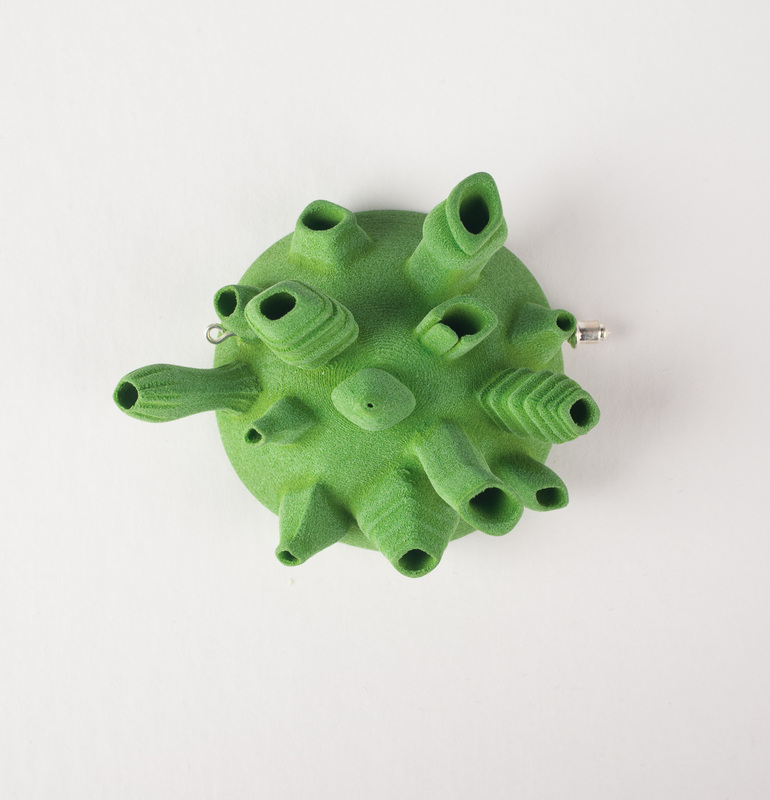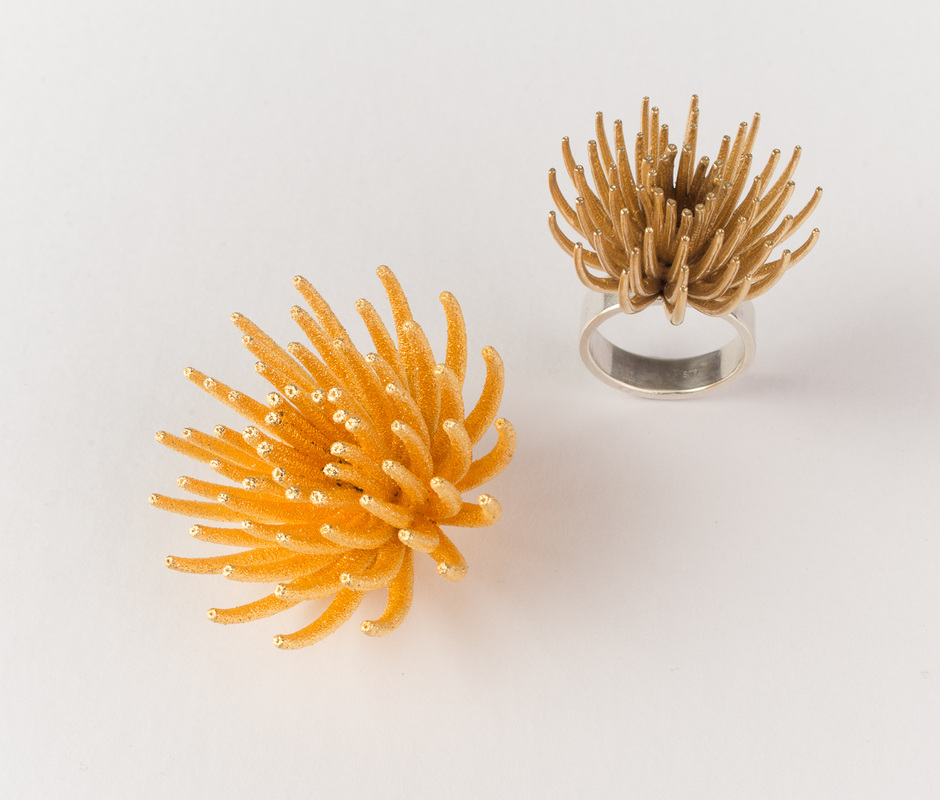Louise Rutherford
|
Louise Rutherford is a fine art jeweller and printmaker based in Wellington, New Zealand. Her first exhibition at Gilberd Marriott Gallery, 'Molten', featured unique silver jewellery and monoprints.
Her next exhibition 'Rockpool' will also include jewellery and prints, but this time the jewellery is made using 3D printing techniques. New exhibition: 'Rockpool'
3D printed jewellery and monoprints by Louise Rutherford 28th November 2014 - 20th January 2015 Gilberd Marriott Gallery, Wellington, New Zealand. Note: gallery closed 24th Dec-5th Jan. |
'Rockpool' exhibition statement, 2014
|
The works in this exhibition are treasures from a rockpool. Discover them by peering past seaweed, lifting a rock or exploring a shell. Rockpools are teeming with tiny life forms and intricate microscopic creatures. They are full of life, colour and activity.
I spent many hours of my childhood combing the beaches and rockpools around Wellington. The natural world of the ocean is a strong part of the visual vocabulary in my work. I draw inspiration from the creatures of the oceans and shores, and from the detritus the sea throws onto the beach. My love of the ocean was kindled by growing up on Wellington and spending time on the beach, and also by childhood visits to Wellington Museum’s marine display “from the shore to the ocean”. The brightly painted exhibit was full of anemones, models of little fish, crayfish and even an octopus hiding in the recesses of the pool. Schools of fish flickered in the shifting play of light on sea-coloured walls. My work is also influenced by my research into marine scientific illustration; especially into the minute unicellular organisms that make up the building blocks of marine life. My research into scientific art and unicellular organisms led me to model and make the structures myself to understand them better. This exhibition aims to push the boundaries of printmaking off the paper and into the third dimension. The prints are bright, lively and colourful, expressing the beauty and complexity of undersea forms and the 3D printed objects have a presence of their own, as they move outside the pictorial plane and into real space. Both the prints and the 3D printed jewellery in this exhibition explore the exquisitely complex, mathematically precise microscopic forms found in rockpools. Marine life forms have a geometric element, but also reflect the organic randomness of nature. I enjoy the way 3D printed jewellery extends the concept of printing as an art form, making complex shapes in materials that would be impossible to create by hand. I’m both a printmaker and a jeweller, and I see the two practices as complementary. They both deal with the interplay of positive and negative forms; the building up and etching, melting or scratching away of surface texture to create a rich piece of art. Nature has elements of both the precise and the random, and I want to reflect this in my work. At a thematic level, my artwork explores the interplay between order and chaos, pattern and randomness. I see this interplay in art and also in life itself in the way that the randomness of individual events can come to assume a pattern when they are viewed at a distance, or from a different perspective. |
Images from 'Molten' 2012
'Molten' exhibition statement:
I enjoy creating strongly textural jewellery and printmaking. My work uses a visual language of strong contrasts, complex organic forms and images of fantastic shifting undersea gardens, alien surfaces pitted with craters, hidden vaults and volcanic lava flows forming and reforming to suggest drama, emotion and movement.
My printmaking practice has developed over the years. I'm a largely self-taught printmaker, and I've incrementally developed the experimental mixture of techniques that gives my work its unique look and feel. I often incorporate natural elements like fibrous palm fronds, flax flowers or dried cabbage tree bark into my work. These elements disturb the traditional boundaries of the printed works to express the energy, drama and movement in both the external natural world, and the internal world of our emotions.
I use an experimental combination of collographic and solarplate printmaking techniques. I enjoy combining printmaking processes such as relief, intaglio and blind embossing together in the one print. I work using a organic process, where a blind embossed palm leaf may appear as a coloured element on the next print. I weave many elements together to create a cohesive bodies of work with interconnecting elements, where each process leads to the next, although it might be turned around or upside down in surprising and unexpected ways.
The printmaking works in this exhibition were printed on a Conrad Machine Co. E-15 Etching Press. I used using Fabriano Artistico 300 gsm or Magnani Incisioni 310 gsm printmaking paper, and printed my work using a combination of Charbonnel oil-based, and Akua Intaglio water based inks.
My jewellery practice has evolved out of my background as a printmaker – the deeply embossed and etched surfaces that I enjoy creating as printmaking plates suggested themselves as three dimensional works in their own right, and I began to create precious metal jewellery using a range of casting techniques. The works in this exhibition were created using the lost-wax casting process. I work using semi-precious stones such as Labrodorite, Sapphires and Rubies and working with metals such as sterling silver, copper and brass.
'Molten' - 29th June-17th July 2012, Gilberd Marriott Gallery, Wellington New Zealand.
I enjoy creating strongly textural jewellery and printmaking. My work uses a visual language of strong contrasts, complex organic forms and images of fantastic shifting undersea gardens, alien surfaces pitted with craters, hidden vaults and volcanic lava flows forming and reforming to suggest drama, emotion and movement.
My printmaking practice has developed over the years. I'm a largely self-taught printmaker, and I've incrementally developed the experimental mixture of techniques that gives my work its unique look and feel. I often incorporate natural elements like fibrous palm fronds, flax flowers or dried cabbage tree bark into my work. These elements disturb the traditional boundaries of the printed works to express the energy, drama and movement in both the external natural world, and the internal world of our emotions.
I use an experimental combination of collographic and solarplate printmaking techniques. I enjoy combining printmaking processes such as relief, intaglio and blind embossing together in the one print. I work using a organic process, where a blind embossed palm leaf may appear as a coloured element on the next print. I weave many elements together to create a cohesive bodies of work with interconnecting elements, where each process leads to the next, although it might be turned around or upside down in surprising and unexpected ways.
The printmaking works in this exhibition were printed on a Conrad Machine Co. E-15 Etching Press. I used using Fabriano Artistico 300 gsm or Magnani Incisioni 310 gsm printmaking paper, and printed my work using a combination of Charbonnel oil-based, and Akua Intaglio water based inks.
My jewellery practice has evolved out of my background as a printmaker – the deeply embossed and etched surfaces that I enjoy creating as printmaking plates suggested themselves as three dimensional works in their own right, and I began to create precious metal jewellery using a range of casting techniques. The works in this exhibition were created using the lost-wax casting process. I work using semi-precious stones such as Labrodorite, Sapphires and Rubies and working with metals such as sterling silver, copper and brass.
'Molten' - 29th June-17th July 2012, Gilberd Marriott Gallery, Wellington New Zealand.

















